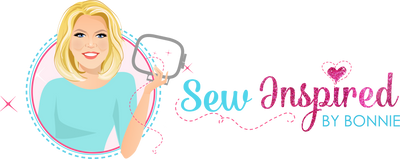
After you become comfortable with embroidery design placement using just one design, it is time to get creative! I will show you how to tackle positioning and stitching multiple embroidery designs on a larger project, like a tree skirt.

We have already covered how easy it is using templates to position single embroidery designs. With my tree skirt project, I had to be more careful and precise with design placement. I used designs from the Painted Poinsettias and Vintage Deer sets. There were three designs for each panel and that panel was repeated eight times around the tree skirt.
I traced out my tree skirt pattern on freezer paper. I included lines where the seam allowances were because I didn't want the embroidery going into the seam allowances. That gave me an idea of what I had to work with.

I printed templates for each of the three designs I used so that I could lay them out on the tree skirt pattern.

Once I had them laid out the way I wanted them, I taped them in place. I can use this master template for each of the tree skirt sections.

These are all 5x7 designs. Combining them also means that they can't be hooped at the same time so I need to add individual crosshairs to the tree skirt fabric. (Note: Some machines have snow man stickers and/or scanners to make this task even easier simply putting a sticker on top of each individual template's center and letting the machine align your design. But creating a master template to work with to repeat a pattern is still a great starting point.)

Using an eyelet cutter on my cutting mat, I cut holes in the center of the crosshair for each individual template. I also cut holes centered on the template’s vertical line, top and bottom, and centered on the horizontal line, left and right.

Put the master template on top of the fabric panel and use a water-soluble, chalk, or FriXion pen to mark a little dot in the holes on the template, two for the vertical and two for the horizontal.

Then, connect the dots, drawing vertical and horizontal lines for each individual design. Also, mark which end of your design is up with an arrow.
It is important that the up arrow for your design is facing the correct direction--which could be facing down depending upon how you laid out your templates. I think we've all done it at least once where we've accidentally stitched the design upside down or sideways.

Just like when hooping the Airplane Adventures design, I fold on one of the crosshair lines (drawn on the fabric) and line it up with the lines drawn on the hoop.

Flip fabric over and you've got it where you want it to go.
Use the master template to help with aligning the embroidery machine needle to the true center of the design. Don't forget to remove the template before you start embroidering!
I hope I've given you some new ideas. You can watch the video here, if you like.
May your day be blessed with perfect stitches and GlitterFlex!


Bonnie Welsh - December 26, 2019
Hi Candy!—You can send project pictures to me and then I can share in our newsletter and social media with your permission of course. I don’t have a place on the website for pictures to be shared for security reasons. But maybe I can create a page where I could share customer photos. That would be nice! Thank you for the nudge. =)
Candy - December 23, 2019
Do you have a place to post images of projects made using your embroidery design?
Bonnie Welsh - December 29, 2018
Shari—I used a pattern from The Little Quilt Company for the tree skirt. Since I made mine with the “quilt as you go” method, I added the binding down each panel and, of course, changed out their appliques for embroidery designs. =)
Shari Reinders - December 28, 2018
Do you have a pattern for the tree skirt you used?
Bonnie Welsh - December 13, 2018
Benita—You’re most welcome! Thank you for taking the time to write. =)
Benita Varas - December 10, 2018
Just like to take the time to say Thank you